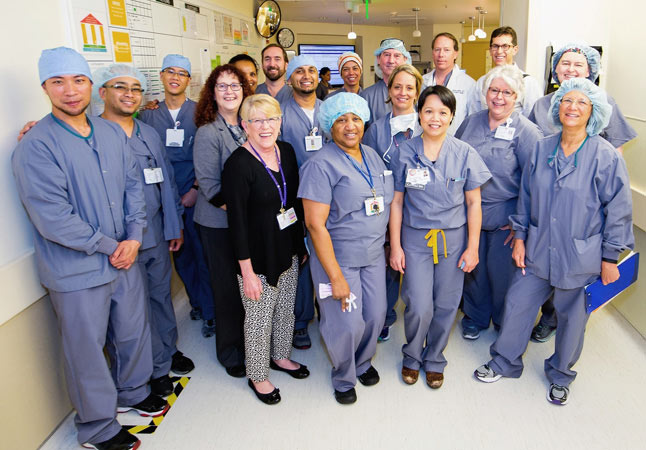Transplant Program at Lucile Packard Children’s Hospital Stanford Again Recognized as a National Leader
* Statistics highlight preeminence of liver, kidney, heart, and multi-organ transplant programs
For Release: April 4, 2016

STANFORD, Calif. — In new data recently released by the Organ Procurement and Transplantation Network, Lucile Packard Children’s Hospital Stanford is once again confirmed as a national leader in pediatric organ transplantation.
The network, which evaluates the status of solid organ transplantation in the United States, noted the following achievements for Lucile Packard Children’s Hospital and Stanford Medicine Children’s Health in 2015:
- Tied for No. 1 in pediatric organ transplant volume for children younger than 18 in the United States. Lucile Packard Children’s Hospital Stanford was also ranked No. 1 in transplant volume in 2014.
- Tied for No. 1 in kidney transplant volume in the United States.
- Stanford has the only pediatric kidney transplant program in the country ranked No. 1 or No. 2 in transplant volume for all of the last five years.
- No. 1 in liver transplant volume in the Western United States.
- Stanford’s team specializes in the smallest and sickest liver recipients: one third are younger than 2 years old, and 45 percent are ill enough to be hospitalized while awaiting transplant.
- According to 2015 data from the Scientific Registry of Transplant Recipients, the liver transplant program has the best three-year patient survival rate in the U.S.
- No. 1 in heart transplant volume in California.
- In addition to performing 20 heart transplants in 2015, the team implanted 11 ventricular assist devices, which help extend patients’ lives until they receive a donor heart.
- Five of the VAD recipients are now being monitored at home, meaning they can be with their families and continue many of their normal activities while awaiting transplant or perhaps avoiding transplant altogether.
“The new data speaks to our phenomenal experience, and experience saves lives,” said Carlos Esquivel, MD, PhD, the Arnold and Barbara Silverman Professor of Surgery and chief of abdominal transplantation at the Stanford University School of Medicine. That experience was certainly on display on March 10 and 11, when the hospital’s transplant team performed lifesaving operations on four children who received, respectively, a heart-kidney, lungs, a liver and a kidney — all from a single deceased donor.
In addition to liver, kidney, heart, intestine, and lung transplants, the hospital also performs combined-organ transplants in which two or more organs, such as heart-lungs, heart-liver, heart-kidney, kidney-liver, or liver-intestine-pancreas are given to the same patient in a single surgery.
The hospital’s high transplant volume, and equally high success rates, are all the more noteworthy because they’re achieved with the most difficult, high-acuity cases.
“Our center is known for helping kids who have been deemed un-transplantable at other hospitals,” said Paul Grimm, MD, medical director of the hospital’s Pediatric Kidney Transplant Program. Those hard-to-transplant patients include many babies and toddlers whose small size makes their surgeries more challenging. “At most children’s kidney transplant programs, nearly all patients are teens and older children. At Packard Children’s, one third of our patients are less than 5 years of age,” Grimm said. “This really speaks to our extraordinary capabilities.”
The hospital was also recently recognized by the U.S. Department of Health and Human Services for its promotion of California’s organ donor registry. The gold award from the Hospital Organ Donation Campaign represents the highest possible level of recognition for efforts to educate and register new donors. It’s a great milestone for the team to celebrate during National Donate Life month in April.
As well as achieving clinical excellence and raising donor awareness, the hospital’s clinician-scientists are building on Stanford Medicine’s history of innovation in transplant. This includes the development of a steroid-free medication regimen for kidney recipients, which, since its invention in the early 2000s, has allowed thousands of children around the world to avoid the negative side effects of steroids.
Today, the team’s NIH-funded research is identifying biomarkers that can pinpoint which transplant recipients are at risk for organ rejection and which are not. The researchers’ ultimate goal is to enable personalized immunosuppression, tailoring each patient’s medication doses to the patient’s own immune response. The work reflects Stanford Medicine’s focus on precision health, the goal of which is to anticipate and prevent disease in the healthy and precisely diagnose and treat disease in the ill.
“Stanford’s clinical and research programs are among the nation’s elite, and we continue to be international leaders in the development of transplant protocols,” Esquivel concluded. “Every bit of our research and every bit of our care teaches us how to get better at what we do. We’re very proud of this recognition, and look forward to continuing our success in the future.”
Authors
Erin Digitale
(650) 724-9175
digitale@stanford.edu
Samantha Dorman
(650) 498-7056
sdorman@stanfordchildrens.org
About Stanford Medicine Children's Health
Stanford Medicine Children’s Health, with Lucile Packard Children’s Hospital Stanford at its center, is the Bay Area’s largest health care system exclusively dedicated to children and expectant mothers. Our network of care includes more than 65 locations across Northern California and more than 85 locations in the U.S. Western region. Along with Stanford Health Care and the Stanford School of Medicine, we are part of Stanford Medicine, an ecosystem harnessing the potential of biomedicine through collaborative research, education, and clinical care to improve health outcomes around the world. We are a nonprofit organization committed to supporting the community through meaningful outreach programs and services and providing necessary medical care to families, regardless of their ability to pay. Discover more at stanfordchildrens.org.
Connect with us:
Download our App: